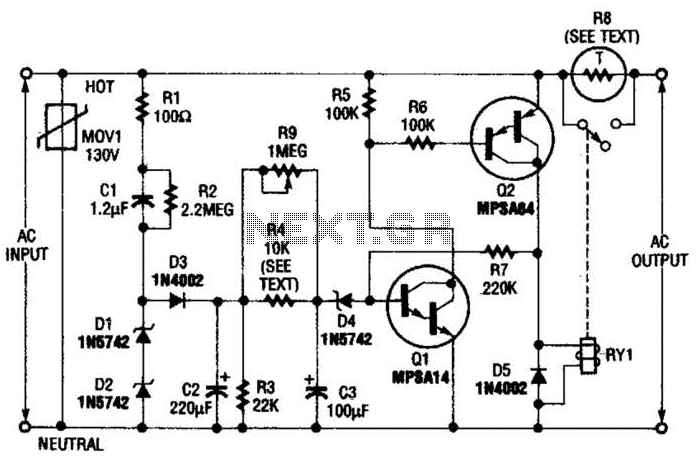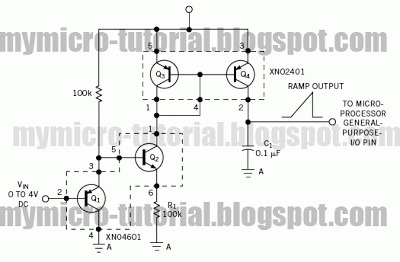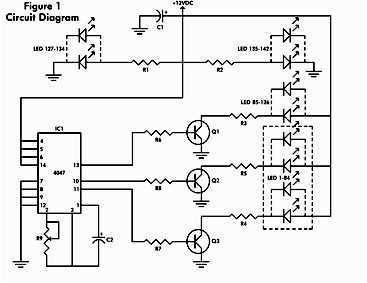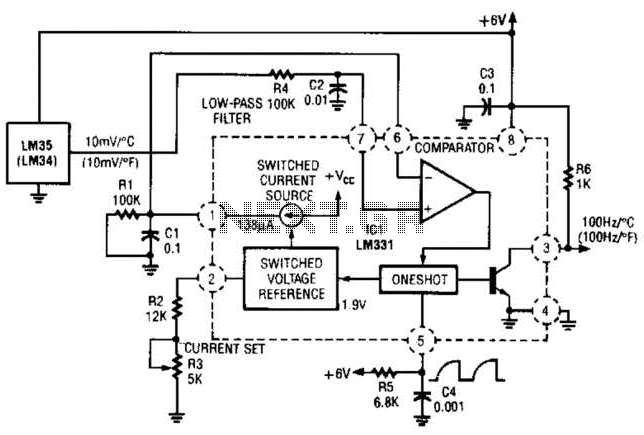
Circuit examples
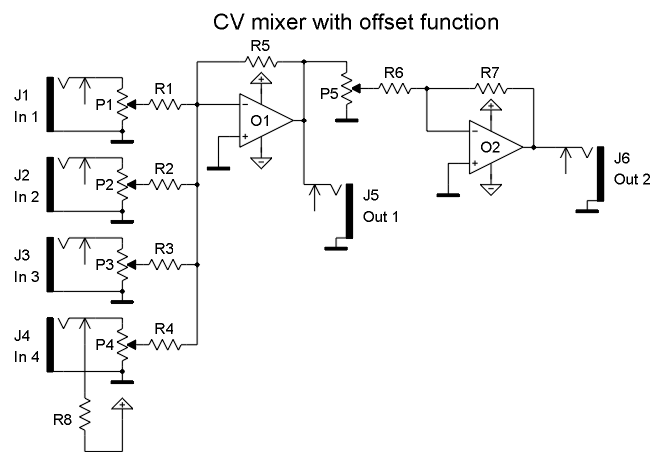
Input J4 features an offset function that is activated only when no plug is inserted into J4, as the switching contact of J4 connects to the positive supply voltage through the protection resistor R8. The inverting sum of all inputs is available at J5, while J6 provides the non-inverting sum. P5 allows for additional attenuation of the entire signal, specifically affecting J6. The CV mixer can be expanded into a matrix mixer, which includes multiple inputs (three in this example) that can be mixed to various outputs (three in this example) with adjustable levels. Each matrix point is equipped with a potentiometer to define the level for that junction. This circuit is suitable for both CV and audio applications, with the flexibility to increase the number of inputs and outputs to the desired configuration. Each output requires a dual OpAmp circuit with an associated output socket. Each input necessitates another socket along with the corresponding number of potentiometers and resistors. To modify the overall amplification, the feedback resistor of the first OpAmp in each output circuit must be adjusted. The basic circuit of a manual gate is depicted, where a 470 Ohm resistor acts as a short circuit protector. Without this resistor, the +12V supply would short to GND when a patch cable is inserted while the button is pressed. The circuit also includes "or-wired" sockets, which are helpful for combining gate or trigger signals. The incoming signals are or-wired, meaning if any input is "high," the output is also "high" (where "high" indicates a positive voltage typically between +5V and +12V). If none of the inputs are high, a 10k pull-down resistor ensures the output is pulled to GND, resulting in a "low" state. While this resistor is often unnecessary due to the input load of the subsequent module acting as a pull-down, it is recommended for safety. The circuit can also be modified to create "and-wired" sockets, though this configuration is less common, as all inputs must be "high" to yield a "high" output. To implement this, the diodes must be reversed (cathodes connected to input sockets), and the resistor must connect between the output and +12V (acting as a pull-up resistor). Additionally, the switching contacts of the input sockets should connect to GND (normalled to GND) to ensure that unused sockets read "low." For instance, a multiple A-180 can be modified with seven additional diodes and one resistor to create seven or-wired sockets and one output socket, requiring interruption of the PCB tracks between the eight multiple sockets (excluding GND connections) and rewiring with the diodes and resistor. This circuit also functions as a simple non-inverting power amplifier, suitable for driving loads such as light bulbs, LED bars, fairy lights, motors, magnets, relays, or other loads, provided the connected load is compatible with the 12V supply voltage. If different supply voltages are required for the operational amplifier and the power transistors, adjustments must be made. If only positive output voltages are necessary, Q2 can be omitted. If an operational amplifier is present in the preceding module (e.g., a mixer A-138), it can be utilized, requiring only the addition of Q1, Q2, and R3. The maximum output current is limited by the specifications of the power transistors, and care must be taken to ensure the power supply can deliver the additional load current. For higher currents (approximately beyond 100mA), transistors should be mounted on appropriate heat sinks. It is crucial to note that the output is not short-circuit protected. If a standard A-100 jack socket is utilized, the output connection must be established before powering on the circuit, as inserting a plug into the jack socket may create a temporary short circuit. Therefore, an alternative socket type is recommended for the output to prevent this issue.Input J4 has offset function provided that no plug is inserted into J4 as the switching contact of J4 is connected to the positive supply voltage in this case (via the protection resistor R8). At J5 the inverting sum of all inputs is available. J6 outputs the non-inverting sum. P5 allows an additional attenuation of the complete signal (affects on ly J6). The CV mixer described above can be expanded to a so-called matrix mixer. This circuit has several inputs available (three in the example circuit) that can be mixed to different outputs (three in the example circuit) with adjustable levels. At each point of the matrix a potentiometer is available that defines the level for the matrix junction in question.
The circuit can be used for CV or audio applications. The number of inputs and outputs can be increased to the desired value of columns and rows. For each of the outputs the two OpAmp circuit with the corresponding output socket is required. For each input another socket and the corresponding quantity of potentiometers and resistors is required. To obtain a higher or smaller overall amplification the feedback resistor of the first (left) OpAmp of each output circuits has to be adjusted (as described above).
The left picture shows the basic circuit of a manual gate. The 470 Ohm resistor serves as a short circuit protector. Without this resistor the +12V supply would be shorted to GND if a patch cable is inserted to the socket while the button is pressed. The left picture shows the circuit of "or-wired" sockets. This circuit is useful to combine gate or trigger signals. The incoming signals are or-wired, i. e. if any of the inputs is "high" the output turns "high" too ("high" means a positive voltage in the range of typical +5.
+12V). If none of the inputs is high the 10k pull-down resistor pulls the output to GND, i. e. "low". For most applications this resistor is not required as the input load of the following module acts as pull-down resistor. But it should be added to be on the safe side. As a modification of this circuit even "and-wired" sockets can be realized. But this type of combination is not used very often: all inputs have to be "high" to turn the output to "high".
For all other conditions the output remains "low". On this the diodes have to be flipped (i. e. the cathodes at connected to the input sockets) and the resistor has to be connected between the output and +12V (so-called pull-up resistor). In addition the switching contacts of the input sockets have to be connected to GND (normalled to GND).
This measure is necessary in order that unused sockets read "low". Otherwise unused sockets would read "high" because of the pull-up resistor. For example a multiple A-180 can be modified with 7 additional diodes and one resistor to obtain seven or-wired sockets and one output socket. For this the pcb tracks between the eight multiple sockets have to be interrupted (not the GND connections, only the "hot" connections) and re-wired with the diodes and the resistor.
This is a simple non-inverting power amplifier that can be used to drive loads like light bulbs, LED bars, fairy lights, motors, magnets, relays or other loads. Pay attention that the connected load is suitable for 12V supply voltage. Otherwise the supply voltages of the operational amplifier and the power transistors have to be adapted.
If only positive output voltages are required Q2 can be omitted. If an operational amplifier is available in the preceding module (e. g. a mixer A-138) this operational amplifier can be used and only Q1, Q2 and R3 have to be added. The maximum output current depends upon the specifications of the power transistors. Pay attention that the power supply has to be able to deliver the additional load current ! For higher currents (~ beyond 100mA) the transistors have to be mounted on suitable heat sinks. Attention:The output is not short circuit protected. If a standard A-100 jack socket is used the output connection has to be establishedbefore power is turned on! During the insertion of a plug into the jack socket a short circuit is made for a short time. Therefore another type of socket is recommended for the output (not the jack socket shown in the picture).
🔗 External reference
The circuit can be used for CV or audio applications. The number of inputs and outputs can be increased to the desired value of columns and rows. For each of the outputs the two OpAmp circuit with the corresponding output socket is required. For each input another socket and the corresponding quantity of potentiometers and resistors is required. To obtain a higher or smaller overall amplification the feedback resistor of the first (left) OpAmp of each output circuits has to be adjusted (as described above).
The left picture shows the basic circuit of a manual gate. The 470 Ohm resistor serves as a short circuit protector. Without this resistor the +12V supply would be shorted to GND if a patch cable is inserted to the socket while the button is pressed. The left picture shows the circuit of "or-wired" sockets. This circuit is useful to combine gate or trigger signals. The incoming signals are or-wired, i. e. if any of the inputs is "high" the output turns "high" too ("high" means a positive voltage in the range of typical +5.
+12V). If none of the inputs is high the 10k pull-down resistor pulls the output to GND, i. e. "low". For most applications this resistor is not required as the input load of the following module acts as pull-down resistor. But it should be added to be on the safe side. As a modification of this circuit even "and-wired" sockets can be realized. But this type of combination is not used very often: all inputs have to be "high" to turn the output to "high".
For all other conditions the output remains "low". On this the diodes have to be flipped (i. e. the cathodes at connected to the input sockets) and the resistor has to be connected between the output and +12V (so-called pull-up resistor). In addition the switching contacts of the input sockets have to be connected to GND (normalled to GND).
This measure is necessary in order that unused sockets read "low". Otherwise unused sockets would read "high" because of the pull-up resistor. For example a multiple A-180 can be modified with 7 additional diodes and one resistor to obtain seven or-wired sockets and one output socket. For this the pcb tracks between the eight multiple sockets have to be interrupted (not the GND connections, only the "hot" connections) and re-wired with the diodes and the resistor.
This is a simple non-inverting power amplifier that can be used to drive loads like light bulbs, LED bars, fairy lights, motors, magnets, relays or other loads. Pay attention that the connected load is suitable for 12V supply voltage. Otherwise the supply voltages of the operational amplifier and the power transistors have to be adapted.
If only positive output voltages are required Q2 can be omitted. If an operational amplifier is available in the preceding module (e. g. a mixer A-138) this operational amplifier can be used and only Q1, Q2 and R3 have to be added. The maximum output current depends upon the specifications of the power transistors. Pay attention that the power supply has to be able to deliver the additional load current ! For higher currents (~ beyond 100mA) the transistors have to be mounted on suitable heat sinks. Attention:The output is not short circuit protected. If a standard A-100 jack socket is used the output connection has to be establishedbefore power is turned on! During the insertion of a plug into the jack socket a short circuit is made for a short time. Therefore another type of socket is recommended for the output (not the jack socket shown in the picture).
🔗 External reference
